Acute Care Nursing: Pathophysiology and Management of Hypertensive Diabetic Patient
VerifiedAdded on 2023/04/24
|13
|3330
|489
AI Summary
This essay discusses the pathophysiology and management of hypertensive diabetic patients. It reviews the case study of Bill McDonald, a 58-year-old male patient who has been diagnosed with type 2 diabetes and hypertension. The essay also presents an education plan for Bill based on assessment of his care and treatment needs.
Contribute Materials
Your contribution can guide someone’s learning journey. Share your
documents today.
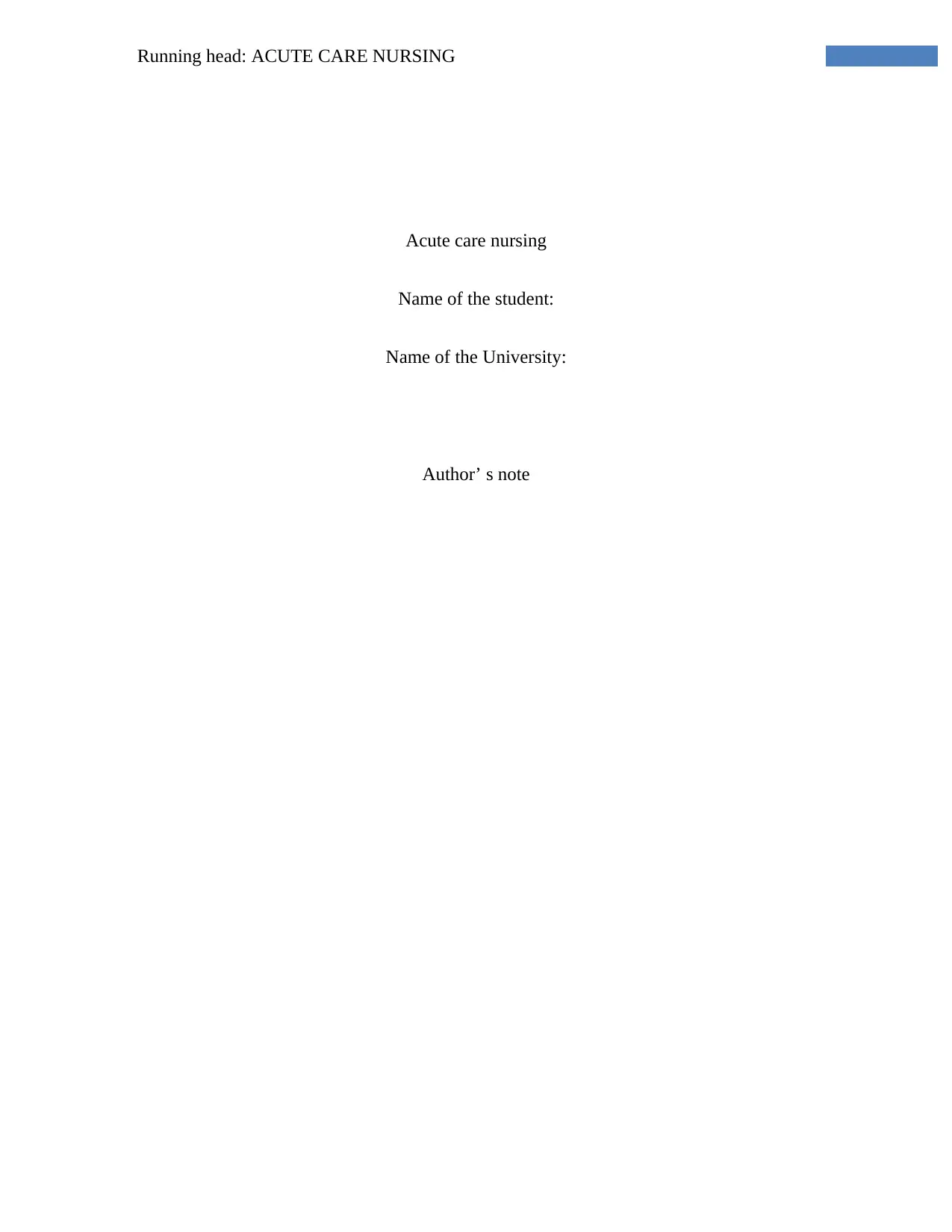
Running head: ACUTE CARE NURSING
Acute care nursing
Name of the student:
Name of the University:
Author’ s note
Acute care nursing
Name of the student:
Name of the University:
Author’ s note
Secure Best Marks with AI Grader
Need help grading? Try our AI Grader for instant feedback on your assignments.
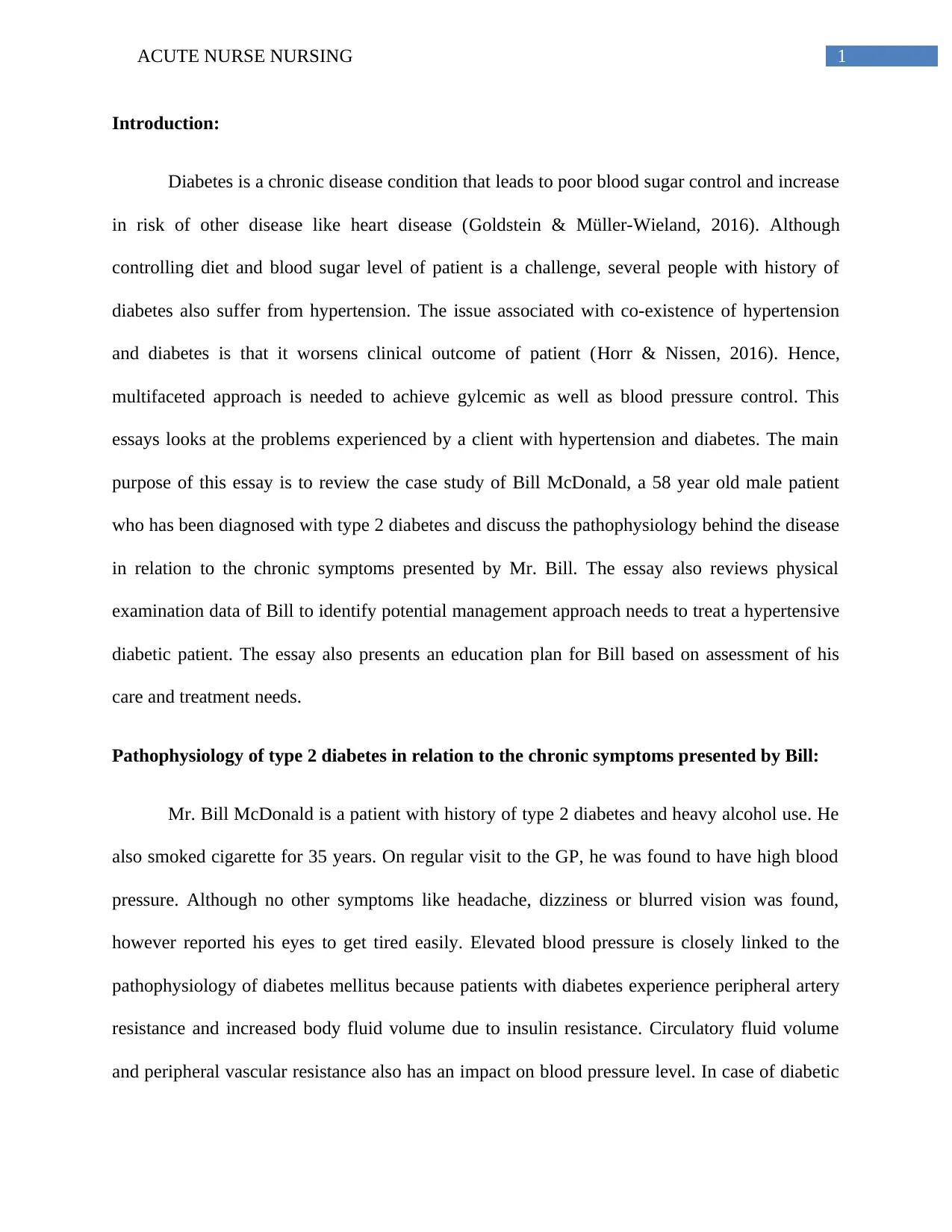
1ACUTE NURSE NURSING
Introduction:
Diabetes is a chronic disease condition that leads to poor blood sugar control and increase
in risk of other disease like heart disease (Goldstein & Müller-Wieland, 2016). Although
controlling diet and blood sugar level of patient is a challenge, several people with history of
diabetes also suffer from hypertension. The issue associated with co-existence of hypertension
and diabetes is that it worsens clinical outcome of patient (Horr & Nissen, 2016). Hence,
multifaceted approach is needed to achieve gylcemic as well as blood pressure control. This
essays looks at the problems experienced by a client with hypertension and diabetes. The main
purpose of this essay is to review the case study of Bill McDonald, a 58 year old male patient
who has been diagnosed with type 2 diabetes and discuss the pathophysiology behind the disease
in relation to the chronic symptoms presented by Mr. Bill. The essay also reviews physical
examination data of Bill to identify potential management approach needs to treat a hypertensive
diabetic patient. The essay also presents an education plan for Bill based on assessment of his
care and treatment needs.
Pathophysiology of type 2 diabetes in relation to the chronic symptoms presented by Bill:
Mr. Bill McDonald is a patient with history of type 2 diabetes and heavy alcohol use. He
also smoked cigarette for 35 years. On regular visit to the GP, he was found to have high blood
pressure. Although no other symptoms like headache, dizziness or blurred vision was found,
however reported his eyes to get tired easily. Elevated blood pressure is closely linked to the
pathophysiology of diabetes mellitus because patients with diabetes experience peripheral artery
resistance and increased body fluid volume due to insulin resistance. Circulatory fluid volume
and peripheral vascular resistance also has an impact on blood pressure level. In case of diabetic
Introduction:
Diabetes is a chronic disease condition that leads to poor blood sugar control and increase
in risk of other disease like heart disease (Goldstein & Müller-Wieland, 2016). Although
controlling diet and blood sugar level of patient is a challenge, several people with history of
diabetes also suffer from hypertension. The issue associated with co-existence of hypertension
and diabetes is that it worsens clinical outcome of patient (Horr & Nissen, 2016). Hence,
multifaceted approach is needed to achieve gylcemic as well as blood pressure control. This
essays looks at the problems experienced by a client with hypertension and diabetes. The main
purpose of this essay is to review the case study of Bill McDonald, a 58 year old male patient
who has been diagnosed with type 2 diabetes and discuss the pathophysiology behind the disease
in relation to the chronic symptoms presented by Mr. Bill. The essay also reviews physical
examination data of Bill to identify potential management approach needs to treat a hypertensive
diabetic patient. The essay also presents an education plan for Bill based on assessment of his
care and treatment needs.
Pathophysiology of type 2 diabetes in relation to the chronic symptoms presented by Bill:
Mr. Bill McDonald is a patient with history of type 2 diabetes and heavy alcohol use. He
also smoked cigarette for 35 years. On regular visit to the GP, he was found to have high blood
pressure. Although no other symptoms like headache, dizziness or blurred vision was found,
however reported his eyes to get tired easily. Elevated blood pressure is closely linked to the
pathophysiology of diabetes mellitus because patients with diabetes experience peripheral artery
resistance and increased body fluid volume due to insulin resistance. Circulatory fluid volume
and peripheral vascular resistance also has an impact on blood pressure level. In case of diabetic
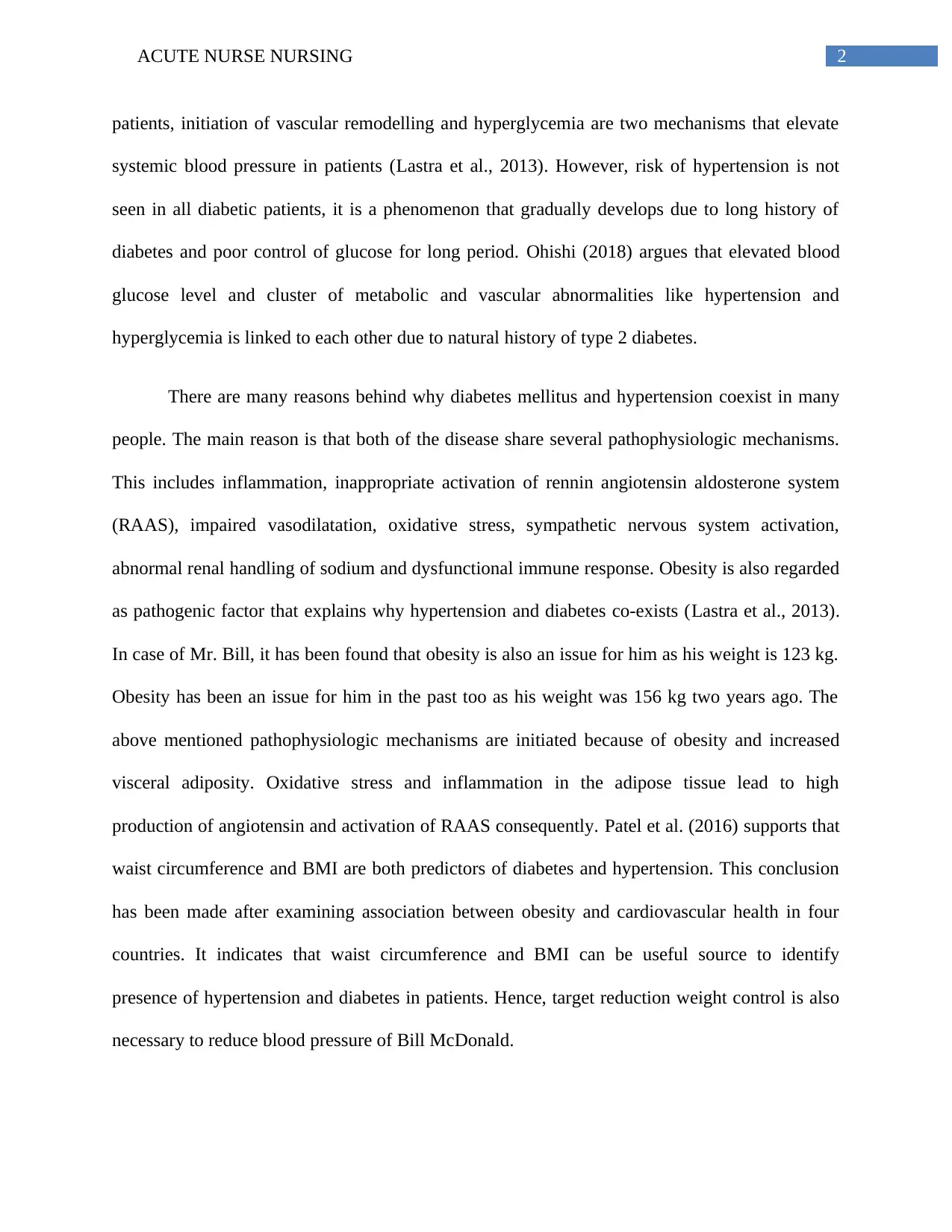
2ACUTE NURSE NURSING
patients, initiation of vascular remodelling and hyperglycemia are two mechanisms that elevate
systemic blood pressure in patients (Lastra et al., 2013). However, risk of hypertension is not
seen in all diabetic patients, it is a phenomenon that gradually develops due to long history of
diabetes and poor control of glucose for long period. Ohishi (2018) argues that elevated blood
glucose level and cluster of metabolic and vascular abnormalities like hypertension and
hyperglycemia is linked to each other due to natural history of type 2 diabetes.
There are many reasons behind why diabetes mellitus and hypertension coexist in many
people. The main reason is that both of the disease share several pathophysiologic mechanisms.
This includes inflammation, inappropriate activation of rennin angiotensin aldosterone system
(RAAS), impaired vasodilatation, oxidative stress, sympathetic nervous system activation,
abnormal renal handling of sodium and dysfunctional immune response. Obesity is also regarded
as pathogenic factor that explains why hypertension and diabetes co-exists (Lastra et al., 2013).
In case of Mr. Bill, it has been found that obesity is also an issue for him as his weight is 123 kg.
Obesity has been an issue for him in the past too as his weight was 156 kg two years ago. The
above mentioned pathophysiologic mechanisms are initiated because of obesity and increased
visceral adiposity. Oxidative stress and inflammation in the adipose tissue lead to high
production of angiotensin and activation of RAAS consequently. Patel et al. (2016) supports that
waist circumference and BMI are both predictors of diabetes and hypertension. This conclusion
has been made after examining association between obesity and cardiovascular health in four
countries. It indicates that waist circumference and BMI can be useful source to identify
presence of hypertension and diabetes in patients. Hence, target reduction weight control is also
necessary to reduce blood pressure of Bill McDonald.
patients, initiation of vascular remodelling and hyperglycemia are two mechanisms that elevate
systemic blood pressure in patients (Lastra et al., 2013). However, risk of hypertension is not
seen in all diabetic patients, it is a phenomenon that gradually develops due to long history of
diabetes and poor control of glucose for long period. Ohishi (2018) argues that elevated blood
glucose level and cluster of metabolic and vascular abnormalities like hypertension and
hyperglycemia is linked to each other due to natural history of type 2 diabetes.
There are many reasons behind why diabetes mellitus and hypertension coexist in many
people. The main reason is that both of the disease share several pathophysiologic mechanisms.
This includes inflammation, inappropriate activation of rennin angiotensin aldosterone system
(RAAS), impaired vasodilatation, oxidative stress, sympathetic nervous system activation,
abnormal renal handling of sodium and dysfunctional immune response. Obesity is also regarded
as pathogenic factor that explains why hypertension and diabetes co-exists (Lastra et al., 2013).
In case of Mr. Bill, it has been found that obesity is also an issue for him as his weight is 123 kg.
Obesity has been an issue for him in the past too as his weight was 156 kg two years ago. The
above mentioned pathophysiologic mechanisms are initiated because of obesity and increased
visceral adiposity. Oxidative stress and inflammation in the adipose tissue lead to high
production of angiotensin and activation of RAAS consequently. Patel et al. (2016) supports that
waist circumference and BMI are both predictors of diabetes and hypertension. This conclusion
has been made after examining association between obesity and cardiovascular health in four
countries. It indicates that waist circumference and BMI can be useful source to identify
presence of hypertension and diabetes in patients. Hence, target reduction weight control is also
necessary to reduce blood pressure of Bill McDonald.

3ACUTE NURSE NURSING
The review of the case study of Bill McDonald also reveals several factors that have led
to diabetes and hypertension. For example, Mr. Bill was an active smoker since the past 35 years.
He had a history of heavy alcohol use too. Gao, Shi & Wang (2017) explains that smoking is one
of the preventable cause of hypertension. Alcohol consumption is also a behaviour that worsens
blood sugar level in diabetic patients and increases the likelihood of severe health consequences
for patient. Alcohol consumption increases blood pressure. Alcohol consumption damage the
arteries by increasing amount of lips and fats in blood and this in turn lead to hardening of the
arteries and hypertension (Husain, Ansari & Ferder, 2014). Hence, vascular injury caused due to
alcohol consumption is the main pathophysiology behind hypertension in Mr. Bill. Current issue
faced by Mr. Bill includes unstable and fluctuating blood glucose control since the past 3
months. This is also linked to presence of risk factors like smoking and alcohol consumption for
the client.
The review of physical examination for Mr. Bill indicates that his pulse rate and
respiratory rate is normal. However, he has been found with pitting oedema in both his lower
legs. The symptom of peripheral edema should be considered as a serious symptom for the client
because it is indicative of diabetes related complications for patients. It may lead to delayed
wound healing for Mr. Bill and this symptoms suggest that extra precaution needs to be taken so
that no injuries or cuts takes place. Controlling edema needs to prioritized while developing care
plan for Mr. Bill.
Potential management approach for hypertensive diabetic patient:
Mr. Bill had a blood pressure of 170/100 mm Hg. This is indicative of high blood
pressure as normal blood pressure is 120/80 mm Hg. The review of his blood glucose level
The review of the case study of Bill McDonald also reveals several factors that have led
to diabetes and hypertension. For example, Mr. Bill was an active smoker since the past 35 years.
He had a history of heavy alcohol use too. Gao, Shi & Wang (2017) explains that smoking is one
of the preventable cause of hypertension. Alcohol consumption is also a behaviour that worsens
blood sugar level in diabetic patients and increases the likelihood of severe health consequences
for patient. Alcohol consumption increases blood pressure. Alcohol consumption damage the
arteries by increasing amount of lips and fats in blood and this in turn lead to hardening of the
arteries and hypertension (Husain, Ansari & Ferder, 2014). Hence, vascular injury caused due to
alcohol consumption is the main pathophysiology behind hypertension in Mr. Bill. Current issue
faced by Mr. Bill includes unstable and fluctuating blood glucose control since the past 3
months. This is also linked to presence of risk factors like smoking and alcohol consumption for
the client.
The review of physical examination for Mr. Bill indicates that his pulse rate and
respiratory rate is normal. However, he has been found with pitting oedema in both his lower
legs. The symptom of peripheral edema should be considered as a serious symptom for the client
because it is indicative of diabetes related complications for patients. It may lead to delayed
wound healing for Mr. Bill and this symptoms suggest that extra precaution needs to be taken so
that no injuries or cuts takes place. Controlling edema needs to prioritized while developing care
plan for Mr. Bill.
Potential management approach for hypertensive diabetic patient:
Mr. Bill had a blood pressure of 170/100 mm Hg. This is indicative of high blood
pressure as normal blood pressure is 120/80 mm Hg. The review of his blood glucose level
Secure Best Marks with AI Grader
Need help grading? Try our AI Grader for instant feedback on your assignments.
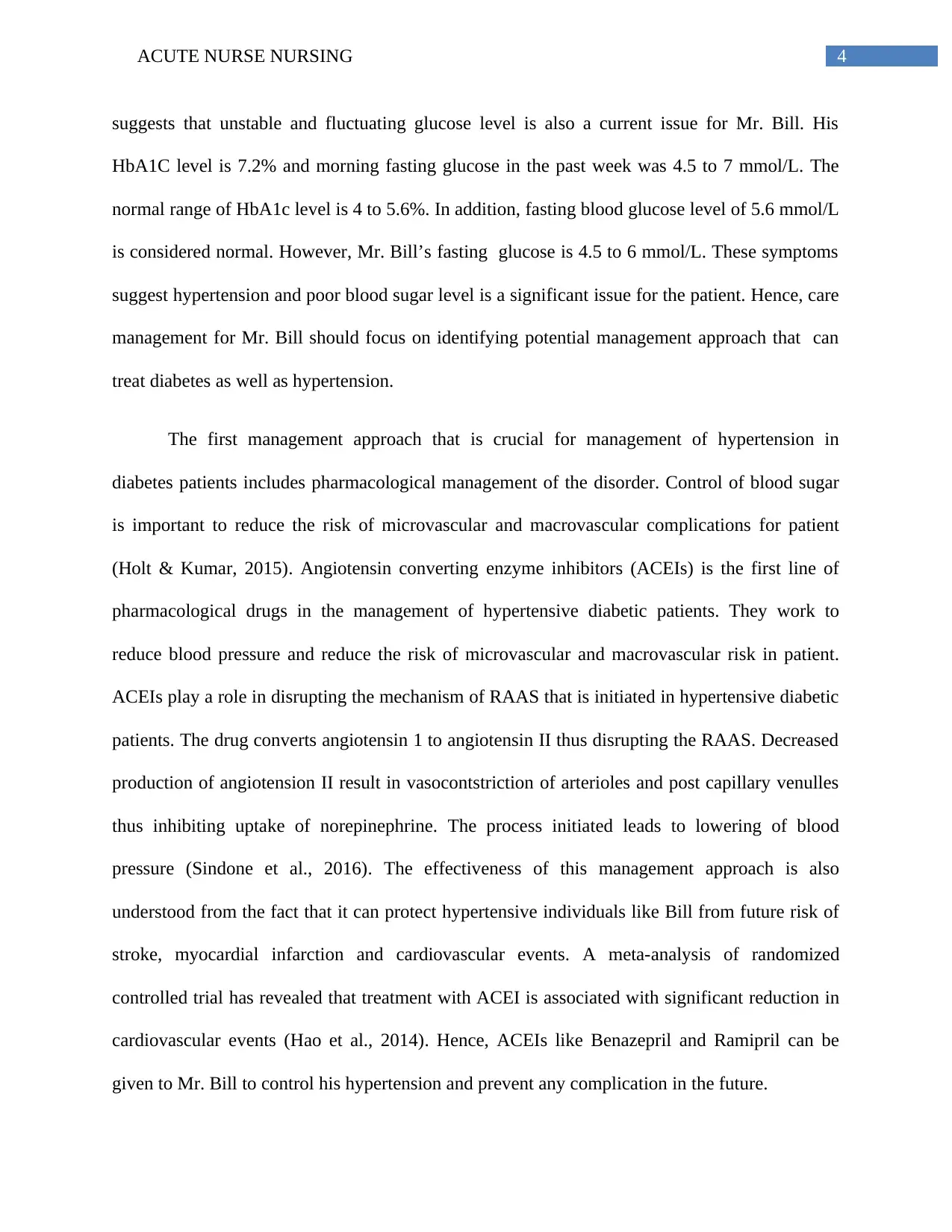
4ACUTE NURSE NURSING
suggests that unstable and fluctuating glucose level is also a current issue for Mr. Bill. His
HbA1C level is 7.2% and morning fasting glucose in the past week was 4.5 to 7 mmol/L. The
normal range of HbA1c level is 4 to 5.6%. In addition, fasting blood glucose level of 5.6 mmol/L
is considered normal. However, Mr. Bill’s fasting glucose is 4.5 to 6 mmol/L. These symptoms
suggest hypertension and poor blood sugar level is a significant issue for the patient. Hence, care
management for Mr. Bill should focus on identifying potential management approach that can
treat diabetes as well as hypertension.
The first management approach that is crucial for management of hypertension in
diabetes patients includes pharmacological management of the disorder. Control of blood sugar
is important to reduce the risk of microvascular and macrovascular complications for patient
(Holt & Kumar, 2015). Angiotensin converting enzyme inhibitors (ACEIs) is the first line of
pharmacological drugs in the management of hypertensive diabetic patients. They work to
reduce blood pressure and reduce the risk of microvascular and macrovascular risk in patient.
ACEIs play a role in disrupting the mechanism of RAAS that is initiated in hypertensive diabetic
patients. The drug converts angiotensin 1 to angiotensin II thus disrupting the RAAS. Decreased
production of angiotension II result in vasocontstriction of arterioles and post capillary venulles
thus inhibiting uptake of norepinephrine. The process initiated leads to lowering of blood
pressure (Sindone et al., 2016). The effectiveness of this management approach is also
understood from the fact that it can protect hypertensive individuals like Bill from future risk of
stroke, myocardial infarction and cardiovascular events. A meta-analysis of randomized
controlled trial has revealed that treatment with ACEI is associated with significant reduction in
cardiovascular events (Hao et al., 2014). Hence, ACEIs like Benazepril and Ramipril can be
given to Mr. Bill to control his hypertension and prevent any complication in the future.
suggests that unstable and fluctuating glucose level is also a current issue for Mr. Bill. His
HbA1C level is 7.2% and morning fasting glucose in the past week was 4.5 to 7 mmol/L. The
normal range of HbA1c level is 4 to 5.6%. In addition, fasting blood glucose level of 5.6 mmol/L
is considered normal. However, Mr. Bill’s fasting glucose is 4.5 to 6 mmol/L. These symptoms
suggest hypertension and poor blood sugar level is a significant issue for the patient. Hence, care
management for Mr. Bill should focus on identifying potential management approach that can
treat diabetes as well as hypertension.
The first management approach that is crucial for management of hypertension in
diabetes patients includes pharmacological management of the disorder. Control of blood sugar
is important to reduce the risk of microvascular and macrovascular complications for patient
(Holt & Kumar, 2015). Angiotensin converting enzyme inhibitors (ACEIs) is the first line of
pharmacological drugs in the management of hypertensive diabetic patients. They work to
reduce blood pressure and reduce the risk of microvascular and macrovascular risk in patient.
ACEIs play a role in disrupting the mechanism of RAAS that is initiated in hypertensive diabetic
patients. The drug converts angiotensin 1 to angiotensin II thus disrupting the RAAS. Decreased
production of angiotension II result in vasocontstriction of arterioles and post capillary venulles
thus inhibiting uptake of norepinephrine. The process initiated leads to lowering of blood
pressure (Sindone et al., 2016). The effectiveness of this management approach is also
understood from the fact that it can protect hypertensive individuals like Bill from future risk of
stroke, myocardial infarction and cardiovascular events. A meta-analysis of randomized
controlled trial has revealed that treatment with ACEI is associated with significant reduction in
cardiovascular events (Hao et al., 2014). Hence, ACEIs like Benazepril and Ramipril can be
given to Mr. Bill to control his hypertension and prevent any complication in the future.
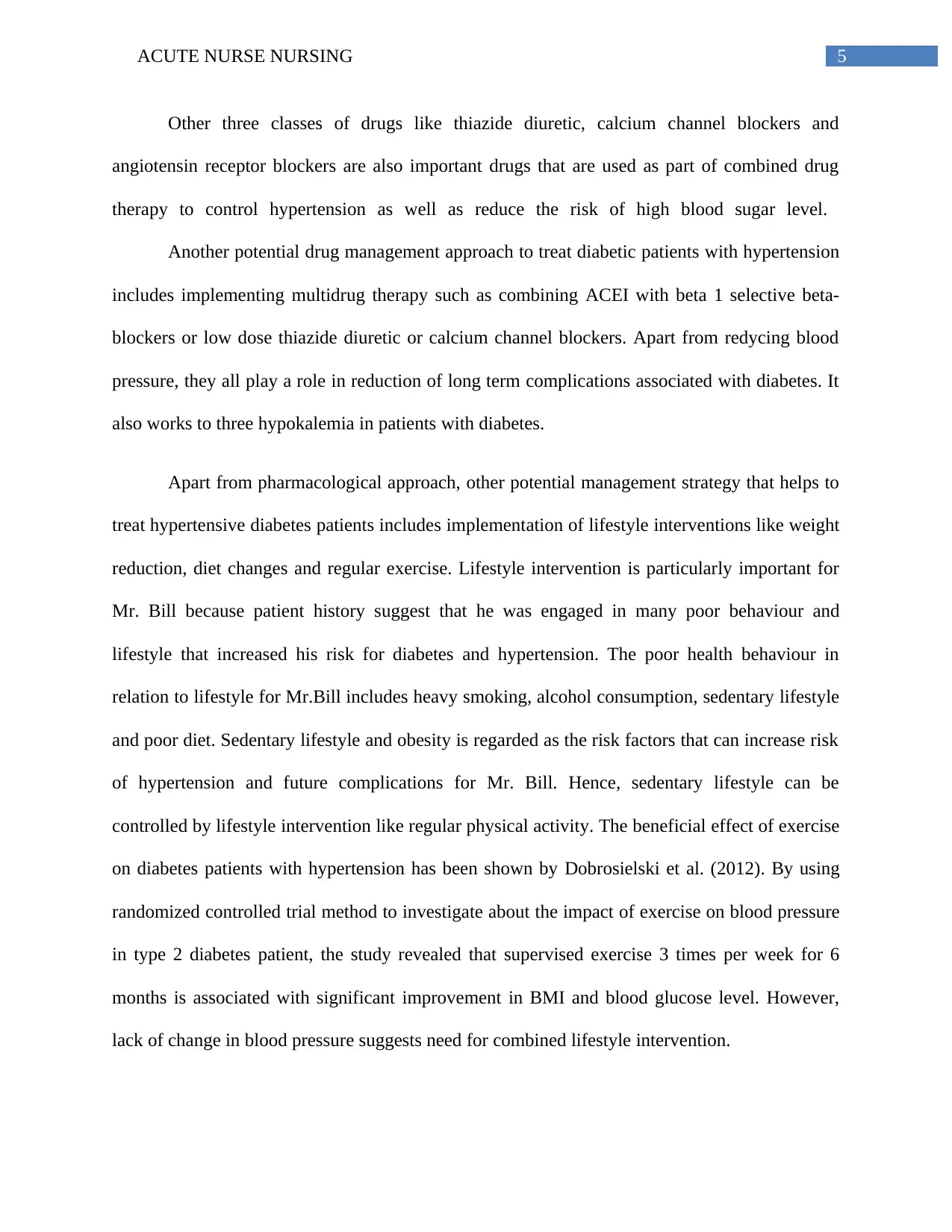
5ACUTE NURSE NURSING
Other three classes of drugs like thiazide diuretic, calcium channel blockers and
angiotensin receptor blockers are also important drugs that are used as part of combined drug
therapy to control hypertension as well as reduce the risk of high blood sugar level.
Another potential drug management approach to treat diabetic patients with hypertension
includes implementing multidrug therapy such as combining ACEI with beta 1 selective beta-
blockers or low dose thiazide diuretic or calcium channel blockers. Apart from redycing blood
pressure, they all play a role in reduction of long term complications associated with diabetes. It
also works to three hypokalemia in patients with diabetes.
Apart from pharmacological approach, other potential management strategy that helps to
treat hypertensive diabetes patients includes implementation of lifestyle interventions like weight
reduction, diet changes and regular exercise. Lifestyle intervention is particularly important for
Mr. Bill because patient history suggest that he was engaged in many poor behaviour and
lifestyle that increased his risk for diabetes and hypertension. The poor health behaviour in
relation to lifestyle for Mr.Bill includes heavy smoking, alcohol consumption, sedentary lifestyle
and poor diet. Sedentary lifestyle and obesity is regarded as the risk factors that can increase risk
of hypertension and future complications for Mr. Bill. Hence, sedentary lifestyle can be
controlled by lifestyle intervention like regular physical activity. The beneficial effect of exercise
on diabetes patients with hypertension has been shown by Dobrosielski et al. (2012). By using
randomized controlled trial method to investigate about the impact of exercise on blood pressure
in type 2 diabetes patient, the study revealed that supervised exercise 3 times per week for 6
months is associated with significant improvement in BMI and blood glucose level. However,
lack of change in blood pressure suggests need for combined lifestyle intervention.
Other three classes of drugs like thiazide diuretic, calcium channel blockers and
angiotensin receptor blockers are also important drugs that are used as part of combined drug
therapy to control hypertension as well as reduce the risk of high blood sugar level.
Another potential drug management approach to treat diabetic patients with hypertension
includes implementing multidrug therapy such as combining ACEI with beta 1 selective beta-
blockers or low dose thiazide diuretic or calcium channel blockers. Apart from redycing blood
pressure, they all play a role in reduction of long term complications associated with diabetes. It
also works to three hypokalemia in patients with diabetes.
Apart from pharmacological approach, other potential management strategy that helps to
treat hypertensive diabetes patients includes implementation of lifestyle interventions like weight
reduction, diet changes and regular exercise. Lifestyle intervention is particularly important for
Mr. Bill because patient history suggest that he was engaged in many poor behaviour and
lifestyle that increased his risk for diabetes and hypertension. The poor health behaviour in
relation to lifestyle for Mr.Bill includes heavy smoking, alcohol consumption, sedentary lifestyle
and poor diet. Sedentary lifestyle and obesity is regarded as the risk factors that can increase risk
of hypertension and future complications for Mr. Bill. Hence, sedentary lifestyle can be
controlled by lifestyle intervention like regular physical activity. The beneficial effect of exercise
on diabetes patients with hypertension has been shown by Dobrosielski et al. (2012). By using
randomized controlled trial method to investigate about the impact of exercise on blood pressure
in type 2 diabetes patient, the study revealed that supervised exercise 3 times per week for 6
months is associated with significant improvement in BMI and blood glucose level. However,
lack of change in blood pressure suggests need for combined lifestyle intervention.
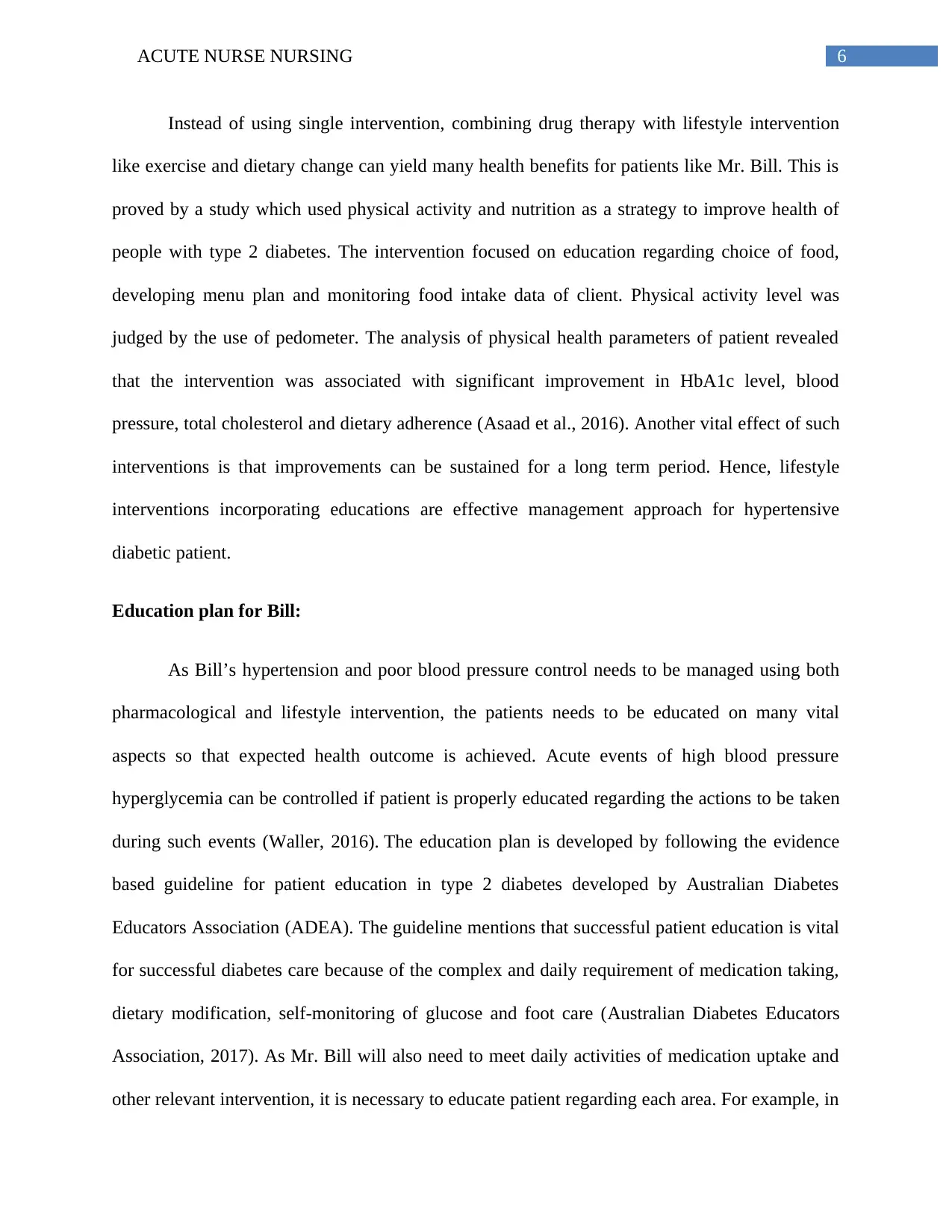
6ACUTE NURSE NURSING
Instead of using single intervention, combining drug therapy with lifestyle intervention
like exercise and dietary change can yield many health benefits for patients like Mr. Bill. This is
proved by a study which used physical activity and nutrition as a strategy to improve health of
people with type 2 diabetes. The intervention focused on education regarding choice of food,
developing menu plan and monitoring food intake data of client. Physical activity level was
judged by the use of pedometer. The analysis of physical health parameters of patient revealed
that the intervention was associated with significant improvement in HbA1c level, blood
pressure, total cholesterol and dietary adherence (Asaad et al., 2016). Another vital effect of such
interventions is that improvements can be sustained for a long term period. Hence, lifestyle
interventions incorporating educations are effective management approach for hypertensive
diabetic patient.
Education plan for Bill:
As Bill’s hypertension and poor blood pressure control needs to be managed using both
pharmacological and lifestyle intervention, the patients needs to be educated on many vital
aspects so that expected health outcome is achieved. Acute events of high blood pressure
hyperglycemia can be controlled if patient is properly educated regarding the actions to be taken
during such events (Waller, 2016). The education plan is developed by following the evidence
based guideline for patient education in type 2 diabetes developed by Australian Diabetes
Educators Association (ADEA). The guideline mentions that successful patient education is vital
for successful diabetes care because of the complex and daily requirement of medication taking,
dietary modification, self-monitoring of glucose and foot care (Australian Diabetes Educators
Association, 2017). As Mr. Bill will also need to meet daily activities of medication uptake and
other relevant intervention, it is necessary to educate patient regarding each area. For example, in
Instead of using single intervention, combining drug therapy with lifestyle intervention
like exercise and dietary change can yield many health benefits for patients like Mr. Bill. This is
proved by a study which used physical activity and nutrition as a strategy to improve health of
people with type 2 diabetes. The intervention focused on education regarding choice of food,
developing menu plan and monitoring food intake data of client. Physical activity level was
judged by the use of pedometer. The analysis of physical health parameters of patient revealed
that the intervention was associated with significant improvement in HbA1c level, blood
pressure, total cholesterol and dietary adherence (Asaad et al., 2016). Another vital effect of such
interventions is that improvements can be sustained for a long term period. Hence, lifestyle
interventions incorporating educations are effective management approach for hypertensive
diabetic patient.
Education plan for Bill:
As Bill’s hypertension and poor blood pressure control needs to be managed using both
pharmacological and lifestyle intervention, the patients needs to be educated on many vital
aspects so that expected health outcome is achieved. Acute events of high blood pressure
hyperglycemia can be controlled if patient is properly educated regarding the actions to be taken
during such events (Waller, 2016). The education plan is developed by following the evidence
based guideline for patient education in type 2 diabetes developed by Australian Diabetes
Educators Association (ADEA). The guideline mentions that successful patient education is vital
for successful diabetes care because of the complex and daily requirement of medication taking,
dietary modification, self-monitoring of glucose and foot care (Australian Diabetes Educators
Association, 2017). As Mr. Bill will also need to meet daily activities of medication uptake and
other relevant intervention, it is necessary to educate patient regarding each area. For example, in
Paraphrase This Document
Need a fresh take? Get an instant paraphrase of this document with our AI Paraphraser
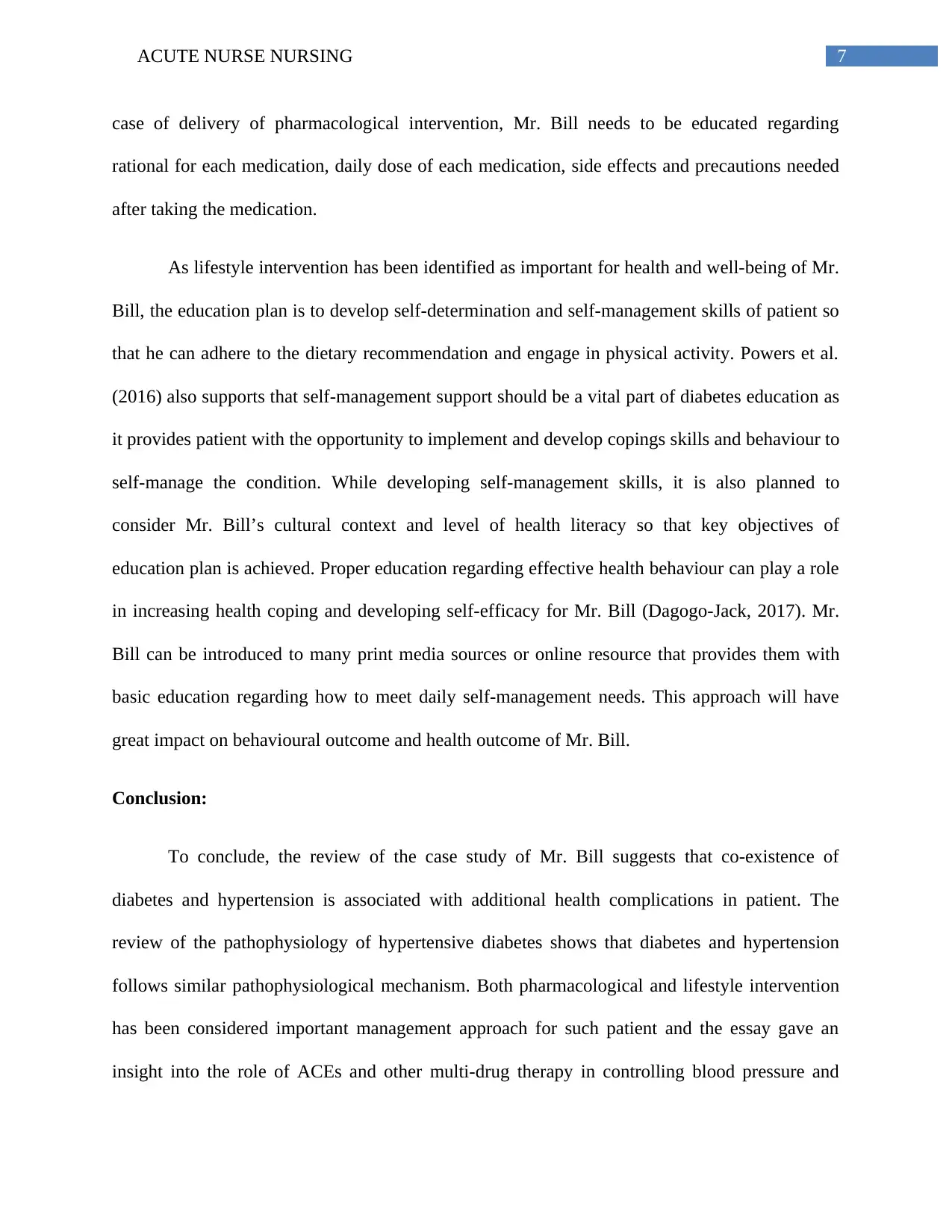
7ACUTE NURSE NURSING
case of delivery of pharmacological intervention, Mr. Bill needs to be educated regarding
rational for each medication, daily dose of each medication, side effects and precautions needed
after taking the medication.
As lifestyle intervention has been identified as important for health and well-being of Mr.
Bill, the education plan is to develop self-determination and self-management skills of patient so
that he can adhere to the dietary recommendation and engage in physical activity. Powers et al.
(2016) also supports that self-management support should be a vital part of diabetes education as
it provides patient with the opportunity to implement and develop copings skills and behaviour to
self-manage the condition. While developing self-management skills, it is also planned to
consider Mr. Bill’s cultural context and level of health literacy so that key objectives of
education plan is achieved. Proper education regarding effective health behaviour can play a role
in increasing health coping and developing self-efficacy for Mr. Bill (Dagogo-Jack, 2017). Mr.
Bill can be introduced to many print media sources or online resource that provides them with
basic education regarding how to meet daily self-management needs. This approach will have
great impact on behavioural outcome and health outcome of Mr. Bill.
Conclusion:
To conclude, the review of the case study of Mr. Bill suggests that co-existence of
diabetes and hypertension is associated with additional health complications in patient. The
review of the pathophysiology of hypertensive diabetes shows that diabetes and hypertension
follows similar pathophysiological mechanism. Both pharmacological and lifestyle intervention
has been considered important management approach for such patient and the essay gave an
insight into the role of ACEs and other multi-drug therapy in controlling blood pressure and
case of delivery of pharmacological intervention, Mr. Bill needs to be educated regarding
rational for each medication, daily dose of each medication, side effects and precautions needed
after taking the medication.
As lifestyle intervention has been identified as important for health and well-being of Mr.
Bill, the education plan is to develop self-determination and self-management skills of patient so
that he can adhere to the dietary recommendation and engage in physical activity. Powers et al.
(2016) also supports that self-management support should be a vital part of diabetes education as
it provides patient with the opportunity to implement and develop copings skills and behaviour to
self-manage the condition. While developing self-management skills, it is also planned to
consider Mr. Bill’s cultural context and level of health literacy so that key objectives of
education plan is achieved. Proper education regarding effective health behaviour can play a role
in increasing health coping and developing self-efficacy for Mr. Bill (Dagogo-Jack, 2017). Mr.
Bill can be introduced to many print media sources or online resource that provides them with
basic education regarding how to meet daily self-management needs. This approach will have
great impact on behavioural outcome and health outcome of Mr. Bill.
Conclusion:
To conclude, the review of the case study of Mr. Bill suggests that co-existence of
diabetes and hypertension is associated with additional health complications in patient. The
review of the pathophysiology of hypertensive diabetes shows that diabetes and hypertension
follows similar pathophysiological mechanism. Both pharmacological and lifestyle intervention
has been considered important management approach for such patient and the essay gave an
insight into the role of ACEs and other multi-drug therapy in controlling blood pressure and

8ACUTE NURSE NURSING
diabetes. Based on Mr. Bill’s health needs and behavioural change needed, the education plan
focus on developing self-efficacy skills of the patient.
diabetes. Based on Mr. Bill’s health needs and behavioural change needed, the education plan
focus on developing self-efficacy skills of the patient.
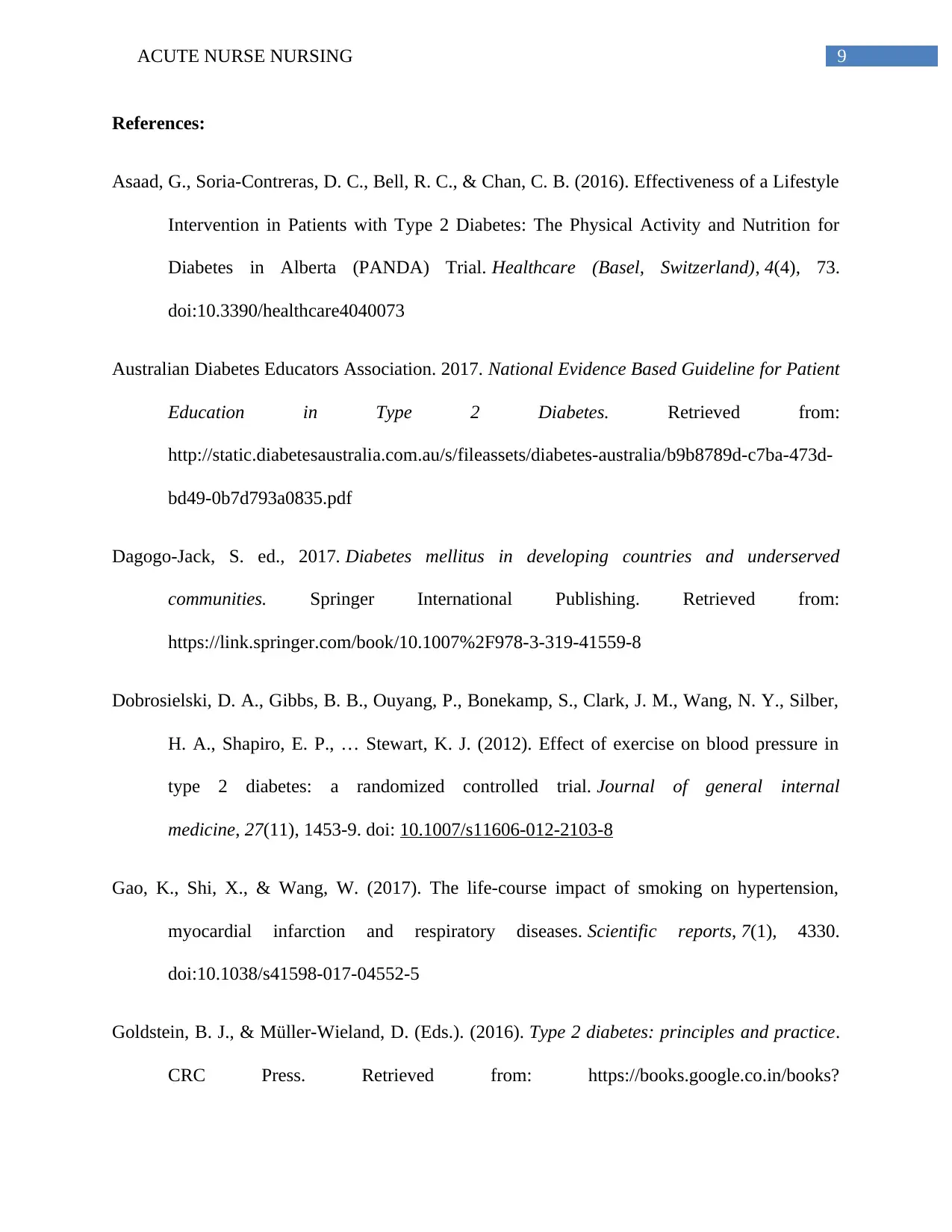
9ACUTE NURSE NURSING
References:
Asaad, G., Soria-Contreras, D. C., Bell, R. C., & Chan, C. B. (2016). Effectiveness of a Lifestyle
Intervention in Patients with Type 2 Diabetes: The Physical Activity and Nutrition for
Diabetes in Alberta (PANDA) Trial. Healthcare (Basel, Switzerland), 4(4), 73.
doi:10.3390/healthcare4040073
Australian Diabetes Educators Association. 2017. National Evidence Based Guideline for Patient
Education in Type 2 Diabetes. Retrieved from:
http://static.diabetesaustralia.com.au/s/fileassets/diabetes-australia/b9b8789d-c7ba-473d-
bd49-0b7d793a0835.pdf
Dagogo-Jack, S. ed., 2017. Diabetes mellitus in developing countries and underserved
communities. Springer International Publishing. Retrieved from:
https://link.springer.com/book/10.1007%2F978-3-319-41559-8
Dobrosielski, D. A., Gibbs, B. B., Ouyang, P., Bonekamp, S., Clark, J. M., Wang, N. Y., Silber,
H. A., Shapiro, E. P., … Stewart, K. J. (2012). Effect of exercise on blood pressure in
type 2 diabetes: a randomized controlled trial. Journal of general internal
medicine, 27(11), 1453-9. doi: 10.1007/s11606-012-2103-8
Gao, K., Shi, X., & Wang, W. (2017). The life-course impact of smoking on hypertension,
myocardial infarction and respiratory diseases. Scientific reports, 7(1), 4330.
doi:10.1038/s41598-017-04552-5
Goldstein, B. J., & Müller-Wieland, D. (Eds.). (2016). Type 2 diabetes: principles and practice.
CRC Press. Retrieved from: https://books.google.co.in/books?
References:
Asaad, G., Soria-Contreras, D. C., Bell, R. C., & Chan, C. B. (2016). Effectiveness of a Lifestyle
Intervention in Patients with Type 2 Diabetes: The Physical Activity and Nutrition for
Diabetes in Alberta (PANDA) Trial. Healthcare (Basel, Switzerland), 4(4), 73.
doi:10.3390/healthcare4040073
Australian Diabetes Educators Association. 2017. National Evidence Based Guideline for Patient
Education in Type 2 Diabetes. Retrieved from:
http://static.diabetesaustralia.com.au/s/fileassets/diabetes-australia/b9b8789d-c7ba-473d-
bd49-0b7d793a0835.pdf
Dagogo-Jack, S. ed., 2017. Diabetes mellitus in developing countries and underserved
communities. Springer International Publishing. Retrieved from:
https://link.springer.com/book/10.1007%2F978-3-319-41559-8
Dobrosielski, D. A., Gibbs, B. B., Ouyang, P., Bonekamp, S., Clark, J. M., Wang, N. Y., Silber,
H. A., Shapiro, E. P., … Stewart, K. J. (2012). Effect of exercise on blood pressure in
type 2 diabetes: a randomized controlled trial. Journal of general internal
medicine, 27(11), 1453-9. doi: 10.1007/s11606-012-2103-8
Gao, K., Shi, X., & Wang, W. (2017). The life-course impact of smoking on hypertension,
myocardial infarction and respiratory diseases. Scientific reports, 7(1), 4330.
doi:10.1038/s41598-017-04552-5
Goldstein, B. J., & Müller-Wieland, D. (Eds.). (2016). Type 2 diabetes: principles and practice.
CRC Press. Retrieved from: https://books.google.co.in/books?
Secure Best Marks with AI Grader
Need help grading? Try our AI Grader for instant feedback on your assignments.
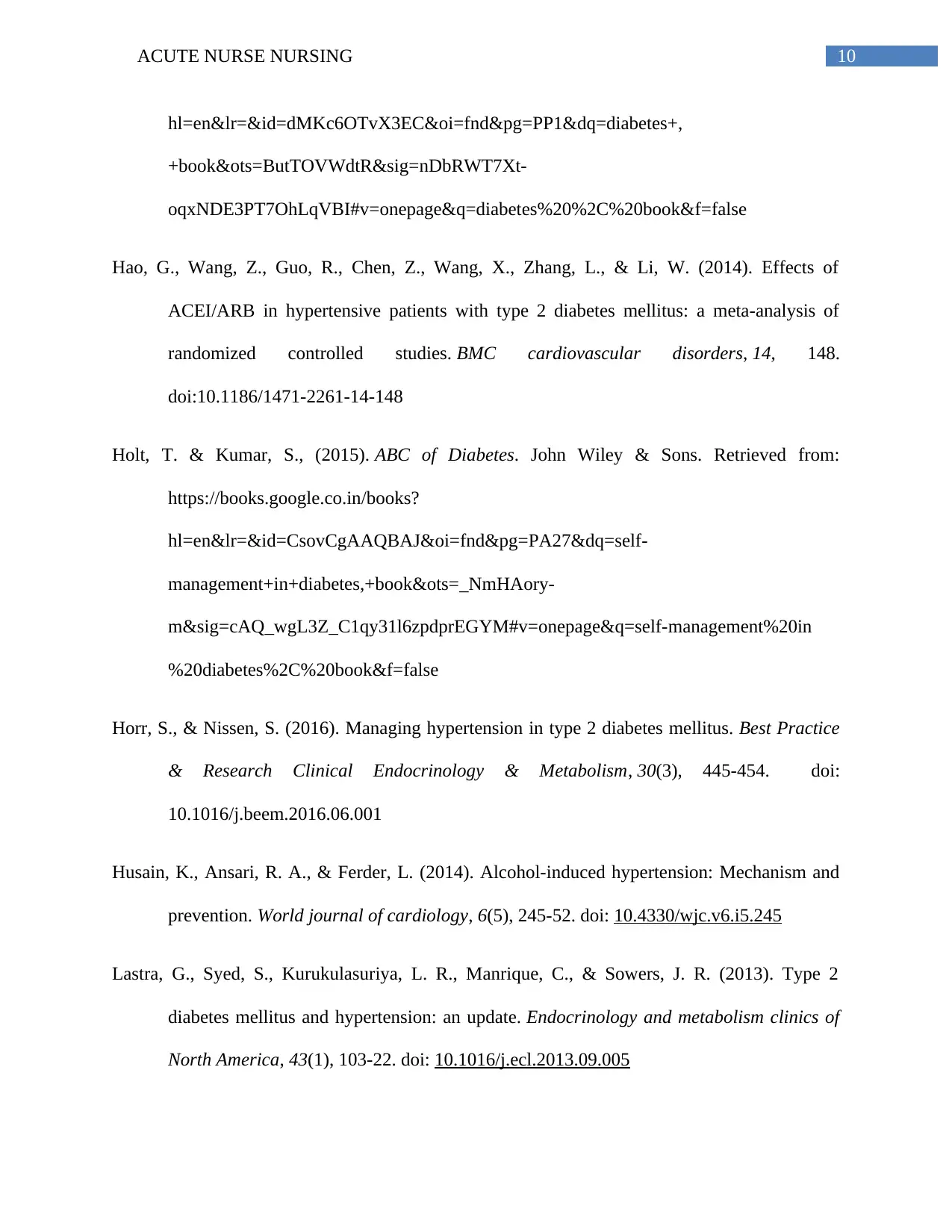
10ACUTE NURSE NURSING
hl=en&lr=&id=dMKc6OTvX3EC&oi=fnd&pg=PP1&dq=diabetes+,
+book&ots=ButTOVWdtR&sig=nDbRWT7Xt-
oqxNDE3PT7OhLqVBI#v=onepage&q=diabetes%20%2C%20book&f=false
Hao, G., Wang, Z., Guo, R., Chen, Z., Wang, X., Zhang, L., & Li, W. (2014). Effects of
ACEI/ARB in hypertensive patients with type 2 diabetes mellitus: a meta-analysis of
randomized controlled studies. BMC cardiovascular disorders, 14, 148.
doi:10.1186/1471-2261-14-148
Holt, T. & Kumar, S., (2015). ABC of Diabetes. John Wiley & Sons. Retrieved from:
https://books.google.co.in/books?
hl=en&lr=&id=CsovCgAAQBAJ&oi=fnd&pg=PA27&dq=self-
management+in+diabetes,+book&ots=_NmHAory-
m&sig=cAQ_wgL3Z_C1qy31l6zpdprEGYM#v=onepage&q=self-management%20in
%20diabetes%2C%20book&f=false
Horr, S., & Nissen, S. (2016). Managing hypertension in type 2 diabetes mellitus. Best Practice
& Research Clinical Endocrinology & Metabolism, 30(3), 445-454. doi:
10.1016/j.beem.2016.06.001
Husain, K., Ansari, R. A., & Ferder, L. (2014). Alcohol-induced hypertension: Mechanism and
prevention. World journal of cardiology, 6(5), 245-52. doi: 10.4330/wjc.v6.i5.245
Lastra, G., Syed, S., Kurukulasuriya, L. R., Manrique, C., & Sowers, J. R. (2013). Type 2
diabetes mellitus and hypertension: an update. Endocrinology and metabolism clinics of
North America, 43(1), 103-22. doi: 10.1016/j.ecl.2013.09.005
hl=en&lr=&id=dMKc6OTvX3EC&oi=fnd&pg=PP1&dq=diabetes+,
+book&ots=ButTOVWdtR&sig=nDbRWT7Xt-
oqxNDE3PT7OhLqVBI#v=onepage&q=diabetes%20%2C%20book&f=false
Hao, G., Wang, Z., Guo, R., Chen, Z., Wang, X., Zhang, L., & Li, W. (2014). Effects of
ACEI/ARB in hypertensive patients with type 2 diabetes mellitus: a meta-analysis of
randomized controlled studies. BMC cardiovascular disorders, 14, 148.
doi:10.1186/1471-2261-14-148
Holt, T. & Kumar, S., (2015). ABC of Diabetes. John Wiley & Sons. Retrieved from:
https://books.google.co.in/books?
hl=en&lr=&id=CsovCgAAQBAJ&oi=fnd&pg=PA27&dq=self-
management+in+diabetes,+book&ots=_NmHAory-
m&sig=cAQ_wgL3Z_C1qy31l6zpdprEGYM#v=onepage&q=self-management%20in
%20diabetes%2C%20book&f=false
Horr, S., & Nissen, S. (2016). Managing hypertension in type 2 diabetes mellitus. Best Practice
& Research Clinical Endocrinology & Metabolism, 30(3), 445-454. doi:
10.1016/j.beem.2016.06.001
Husain, K., Ansari, R. A., & Ferder, L. (2014). Alcohol-induced hypertension: Mechanism and
prevention. World journal of cardiology, 6(5), 245-52. doi: 10.4330/wjc.v6.i5.245
Lastra, G., Syed, S., Kurukulasuriya, L. R., Manrique, C., & Sowers, J. R. (2013). Type 2
diabetes mellitus and hypertension: an update. Endocrinology and metabolism clinics of
North America, 43(1), 103-22. doi: 10.1016/j.ecl.2013.09.005
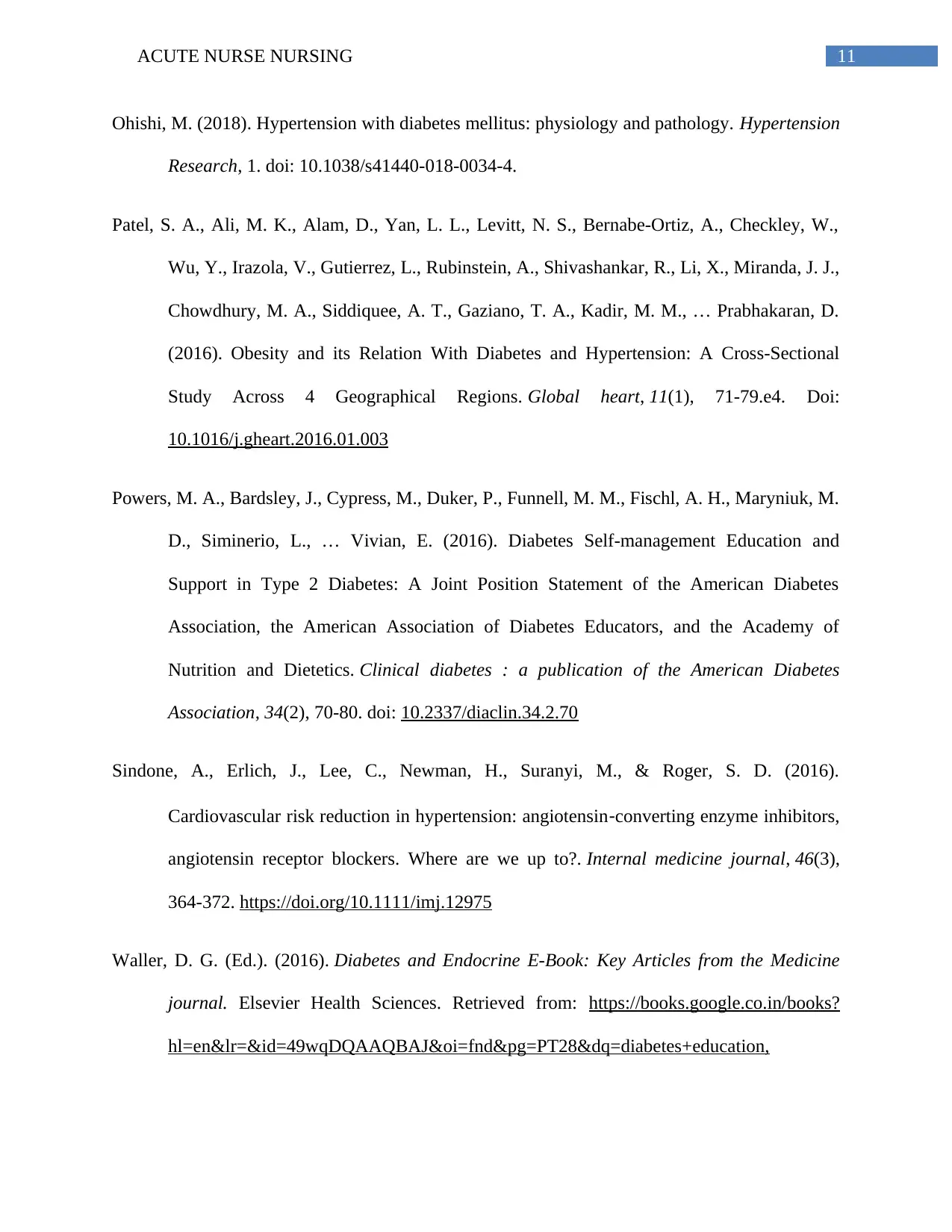
11ACUTE NURSE NURSING
Ohishi, M. (2018). Hypertension with diabetes mellitus: physiology and pathology. Hypertension
Research, 1. doi: 10.1038/s41440-018-0034-4.
Patel, S. A., Ali, M. K., Alam, D., Yan, L. L., Levitt, N. S., Bernabe-Ortiz, A., Checkley, W.,
Wu, Y., Irazola, V., Gutierrez, L., Rubinstein, A., Shivashankar, R., Li, X., Miranda, J. J.,
Chowdhury, M. A., Siddiquee, A. T., Gaziano, T. A., Kadir, M. M., … Prabhakaran, D.
(2016). Obesity and its Relation With Diabetes and Hypertension: A Cross-Sectional
Study Across 4 Geographical Regions. Global heart, 11(1), 71-79.e4. Doi:
10.1016/j.gheart.2016.01.003
Powers, M. A., Bardsley, J., Cypress, M., Duker, P., Funnell, M. M., Fischl, A. H., Maryniuk, M.
D., Siminerio, L., … Vivian, E. (2016). Diabetes Self-management Education and
Support in Type 2 Diabetes: A Joint Position Statement of the American Diabetes
Association, the American Association of Diabetes Educators, and the Academy of
Nutrition and Dietetics. Clinical diabetes : a publication of the American Diabetes
Association, 34(2), 70-80. doi: 10.2337/diaclin.34.2.70
Sindone, A., Erlich, J., Lee, C., Newman, H., Suranyi, M., & Roger, S. D. (2016).
Cardiovascular risk reduction in hypertension: angiotensin‐converting enzyme inhibitors,
angiotensin receptor blockers. Where are we up to?. Internal medicine journal, 46(3),
364-372. https://doi.org/10.1111/imj.12975
Waller, D. G. (Ed.). (2016). Diabetes and Endocrine E-Book: Key Articles from the Medicine
journal. Elsevier Health Sciences. Retrieved from: https://books.google.co.in/books?
hl=en&lr=&id=49wqDQAAQBAJ&oi=fnd&pg=PT28&dq=diabetes+education,
Ohishi, M. (2018). Hypertension with diabetes mellitus: physiology and pathology. Hypertension
Research, 1. doi: 10.1038/s41440-018-0034-4.
Patel, S. A., Ali, M. K., Alam, D., Yan, L. L., Levitt, N. S., Bernabe-Ortiz, A., Checkley, W.,
Wu, Y., Irazola, V., Gutierrez, L., Rubinstein, A., Shivashankar, R., Li, X., Miranda, J. J.,
Chowdhury, M. A., Siddiquee, A. T., Gaziano, T. A., Kadir, M. M., … Prabhakaran, D.
(2016). Obesity and its Relation With Diabetes and Hypertension: A Cross-Sectional
Study Across 4 Geographical Regions. Global heart, 11(1), 71-79.e4. Doi:
10.1016/j.gheart.2016.01.003
Powers, M. A., Bardsley, J., Cypress, M., Duker, P., Funnell, M. M., Fischl, A. H., Maryniuk, M.
D., Siminerio, L., … Vivian, E. (2016). Diabetes Self-management Education and
Support in Type 2 Diabetes: A Joint Position Statement of the American Diabetes
Association, the American Association of Diabetes Educators, and the Academy of
Nutrition and Dietetics. Clinical diabetes : a publication of the American Diabetes
Association, 34(2), 70-80. doi: 10.2337/diaclin.34.2.70
Sindone, A., Erlich, J., Lee, C., Newman, H., Suranyi, M., & Roger, S. D. (2016).
Cardiovascular risk reduction in hypertension: angiotensin‐converting enzyme inhibitors,
angiotensin receptor blockers. Where are we up to?. Internal medicine journal, 46(3),
364-372. https://doi.org/10.1111/imj.12975
Waller, D. G. (Ed.). (2016). Diabetes and Endocrine E-Book: Key Articles from the Medicine
journal. Elsevier Health Sciences. Retrieved from: https://books.google.co.in/books?
hl=en&lr=&id=49wqDQAAQBAJ&oi=fnd&pg=PT28&dq=diabetes+education,

12ACUTE NURSE NURSING
+book&ots=ML69laHiEu&sig=J8CggPhPDP2V1GLjFtyornAeBBc#v=onepage&q=diab
etes%20education%2C%20book&f=false
+book&ots=ML69laHiEu&sig=J8CggPhPDP2V1GLjFtyornAeBBc#v=onepage&q=diab
etes%20education%2C%20book&f=false
1 out of 13
Your All-in-One AI-Powered Toolkit for Academic Success.
+13062052269
info@desklib.com
Available 24*7 on WhatsApp / Email
![[object Object]](/_next/static/media/star-bottom.7253800d.svg)
Unlock your academic potential
© 2024 | Zucol Services PVT LTD | All rights reserved.





